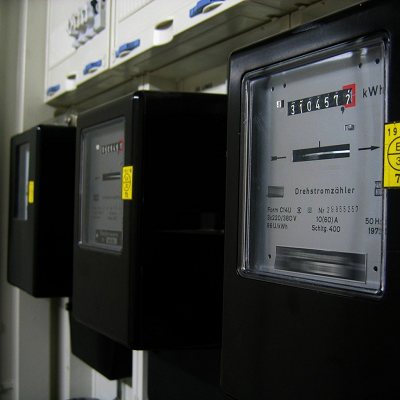What are MPAN and MPRN numbers and where can you find them?
If you’ve ever switched business gas and electricity, you’ve probably been asked for your MPAN and MPRN numbers. These are unique numbers that allow suppliers to identify the property at which you're looking to switch energy.
Here’s all you need to know about what they are and how to find them.

Five-point summary
- MPAN and MPRN are unique UK business energy meter numbers that identify your exact electricity and gas supply points when you switch business gas or electricity.
- An MPAN (Meter Point Administration Number) is a 21‑digit electricity supply number that appears on your bill, not usually on the meter, and includes details like profile class and distribution region.
- An MPRN (Meter Point Reference Number) is a 6 to 10-digit gas supply number printed on your gas meter and bills; it is different from the meter serial number and does not change when you switch business gas suppliers.
- UK business owners can find MPAN and MPRN without a bill using services such as Find My Supplier, UK Power Networks and regional distribution network operator helplines based on postcode and address.
- Knowing your MPAN and MPRN is essential when moving business premises or switching UK business energy, as they confirm the correct meter and prevent errors, especially if you have multiple locations.
What is an MPAN number?
Your Meter Point Administration Number (MPAN) is the unique identity reference number for your electricity meter. Sometimes called an ‘S number’ or ‘Supply Number’, your MPAN should be easy to spot on your meter or bill as it’s a 21-digit number that begins with an ‘S’.
Your MPAN is essentially an electricity reference number that is unique to your premises and is used by energy suppliers to identify your electricity supply point. This means that, unlike your customer reference number, it won’t change if you switch business electricity suppliers.
Here’s an example of what your MPAN number on your bill should look like:

What do the digits on an MPAN mean?
Here’s a breakdown of what all the digits on your electricity MPAN number relate to:
Profile class
Shown as ‘01’ in the example above, the first two numbers after the S refer to your meter’s profile class.
This is used to give suppliers an idea of the typical electricity usage at your property, and the different classes break down as follows:
- Profile Class 1 (01) - Domestic Unrestricted Customers.
- Profile Class 2 (02) - Domestic Economy 7 Customers.
- Profile Class 3 (03) - Non-Domestic Unrestricted Customers.
- Profile Class 4 (04) - Non-Domestic Economy 7 Customers.
- Profile Class 5 (05) - Non-Domestic Maximum Demand (MD) Customers with a Peak Load Factor (LF) of less than 20%.
- Profile Class 6 (06) – Non-Domestic Maximum Demand Customers with a Peak Load Factor between 20% and 30%.
- Profile Class 7 (07) – Non-Domestic Maximum Demand Customers with a Peak Load Factor between 30% and 40%.
- Profile Class 8 (08) – Non-Domestic Maximum Demand Customers with a Peak Load Factor over 40%.
- Profile Class 00 - Peak load usage of electricity above 100 kW.
Peak Load Factor is the ratio of electricity (measured in kWh) used in a given period, divided by the total possible kilowatt-hours that could have been used in the same period, at the peak kW level your business can use. It essentially refers to the way in which your business uses electricity.
It’s also worth noting that Ofgem regulation P272 means that if your meter’s S number is between 05 and 08, your meter will automatically be re-profiled as half-hourly meters.
Meter Time Switch Code (MTC)
The next three numbers (shown as 123 above) refer to whether your meter is a single rate or time of use meters. Most businesses will have a single rate, but certain businesses benefit from different day/night rates or weekend rates.
Line Loss Factor (LLF)
The next three numbers (shown as 456 above) refer to the Distribution Use of System (DUoS) charges. Line loss is the amount of electricity lost as it is supplied to your meter, and this is the fee charged to suppliers by the distribution network, to cover the cost of using the networks and cables in your area.
This is why you may find your electricity bills are more expensive on any premises that are further away from a distribution centre - more distance means longer wires, which equals higher resistance and greater line loss. Around 7% of all electricity generated is lost in this way, and can also occur as a result of energy theft, metering inaccuracies or errors with unmetered fixtures, such as street lights.
Distribution ID
The next two digits (shown as 16 above) identify the regional distribution company for your electricity supply. This is the number you need to use to find out which distribution company operates the electricity network in your area and is responsible for the management of the wires that deliver electricity to your property.
Meter Point ID
The next eight digits are usually split into to (shown as 6789 and 0123 above) identifies your meter and is unique to your distribution area.
Check digit
The final three-digit number (shown as 222 above) is calculated from the Distributor ID and Meter Point ID numbers to verify both numbers.
How to find your MPAN number
Unlike your MPRN for the gas network, the MPAN number isn’t actually printed anywhere on your electricity meter. The simplest way to find your MPAN number is to check the top left or bottom right of your last electricity bill.
If you haven’t got a previous bill to hand, you can get your electricity supply number by ringing your regional electricity supplier on one of the numbers below. The ID numbers shown should correlate to the Distribution ID on your meter, depending upon your region.
| ID | Name | Operator | Phone Number |
| 10 | Eastern England | UK Power Networks | 0800 029 4285 |
| 11 | East Midlands | Western Power Distribution | 0800 096 3080 |
| 12 | London | UK Power Networks | 0800 029 4285 |
| 13 | Merseyside and Northern Wales | SP Energy Networks | 0330 10 10 444 |
| 14 | West Midlands | Western Power Distribution | 0800 096 3080 |
| 15 | North Eastern England | Northern Powergrid | 0800 011 3332 |
| 16 | North Western England Electricity | North West | 0800 048 1820 |
| 17 | Northern Scotland | Scottish & Southern Electricity Networks | 0800 048 3516 |
| 18 | Southern Scotland | SP Energy Networks | 0330 10 10 444 |
| 19 | South Eastern England | UK Power Networks | 0800 029 4285 |
| 20 | Southern England | Scottish & Southern Electricity Networks | 0800 048 3516 |
| 21 | Southern Wales | Western Power Distribution | 0800 096 3080 |
| 22 | South Western England | Western Power Distribution | 0800 096 3080 |
| 23 | Yorkshire | Northern Powergrid | 0800 011 3332 |
If you’re still not sure on the operator for your area, you can look it up with the Energy Networks Association.
Run a price comparison now to find out the latest business gas prices.
What is an MPRN number?
A Meter Point Reference Number (MPRN) is the identity reference number for your gas meter. Sometimes called an ‘M’ number, this code is made up of between six and 10 numbers and is unique to your business premises. This means that, unlike your customer reference number, it won’t change if you switch business gas suppliers.
Here’s an example of what your MPRN number on your bill should look like:

Is my gas meter serial number the same as MPRN?
No. Your gas meter serial number (MSN) is a number that’s on your physical meter box. It’s made up of letters and numbers. It acts like an ID for your meter box.
- If you have a standard meter, the MSN is normally above or below the barcode. It’s a long number between 9 and 12 digits. For gas meters, the number normally starts with ‘L’ and ends with ‘M’.
- If you have a business smart meter the MSN is normally on the front of the meter box, right by the barcode. On electricity smart meters, the number starts with either 14P or 15P. On gas smart meters, it starts with G4P.
How to find your MPRN number
If you want to know where to find your MPRN number on your gas meter, check on your meter for a number of between six and 10 digits. You’ll also be able to find your MPRN number on a gas bill, usually listed under ‘Details of charges’ and listed as ‘Meter Point Reference’.
If your gas meter point reference number begins with ‘74’ or ‘75’ then your gas is supplied by an Independent Gas Transporter (IGT). Although Ofgem, the energy regulator, caps the amount IGTs can charge, rates are often more expensive when you get your gas in this way.
Can I find my MPAN number on my meter?
No, you won’t find your MPAN number on your electricity meter. It’ll be on your last electricity bill - most likely in the top left-hand corner or bottom right.
How can I find my MPAN and MRPN numbers without a bill?
If you can’t find the gas meter number on your meter and you don’t have a bill to hand, you can get your MPRN by entering your building name or number and postcode at Find My Supplier.
To find your MPAN number you can try searching on UK Power Networks or call your local distribution network using the table above. You can also try calling the Meter Number Helpline on 0870 608 1524. If you still can't find your numbers, give the tech-enabled experts at Bionic a call.
Why do you need to know your energy meter numbers?
Your MPAN and MPRN aren’t something you’ll need to use very often, and it’s likely you’ll only ever come across them when moving business premises or switching energy suppliers. It’s important that you do know your electricity supply number and gas supply number in both these instances, as both are unique to your property and let your supplier know they have the right meter.
If you’re moving into new business premises, you might need to give your supplier the MPAN and MPRN numbers from both your old and new properties.
Will your MPAN and MPRN change with a new meter?
An MPAN number or MPRN number identifies each individual meter – so if you add another location to your business, then you’ll have a new meter and number at the added location. This won’t replace your existing meter numbers – you'll just have another one.
Will your MPAN and MPRN change if you switch suppliers?
Your MPAN and MPRN identify the meter at your property, so the only time these numbers will change is if you move to new premises. If you switch suppliers but don’t move to new business property, your numbers won’t change.
What is an Independent Gas Transporter (IGT)?
If your business is situated in a rural area, then you may have your gas delivered by an Independent Gas Transporter (IGT), this is an independent company that manages the gas pipes that supply your home. But for the majority of the UK, gas is supplied through the National Grid.
Will MHHS affect meter profile classes?
Yes, MHHS is expected to phase out the old profile classes for many sites and replace them with half‑hourly settlement based on your actual smart meter data. MHHS, or Market‑wide Half‑Hourly Settlement, is a major UK industry change that uses detailed half‑hourly readings so your business electricity charges more closely reflect when you use power, not just how much you use overall.
Find out more in our guide to Market‑wide Half‑Hourly Settlement (MHHS).
Compare, switch and renew with Bionic
The simplest way to switch business gas and business electricity suppliers is to get in touch with Bionic’s business energy experts.
One call to our tech-enabled team is all it takes to compare deals from our panel of trusted suppliers, switch to a better deal and potentially save hundreds of pounds - money which can be put straight back into your business.
Start a business energy price comparison online today.
Frequently asked questions (FAQS) on MPAN and MPRN
Still not quite sure about your MPAN and MPRN? Here are the answers to some of the most frequently asked questions.
What is an MPAN number on my UK business electricity bill?
An MPAN is your Meter Point Administration Number, a 21‑digit electricity supply reference that uniquely identifies your business premises on the UK power network and is used when you switch business electricity.
How do I find my MPAN and MPRN numbers in the UK?
You can usually find your MPAN on your business electricity bill and your MPRN on your gas bill or meter, or use UK services like Find My Supplier and UK Power Networks with your postcode and address.
Do my MPAN and MPRN change if I switch UK business energy supplier?
No, your MPAN and MPRN stay linked to the meter at your current business property and only change if you move premises or add a new location with an additional meter.
What is the difference between an MPRN and a gas meter serial number in the UK?
Your MPRN is a 6 to 10-digit gas supply number unique to the site, while the meter serial number is printed on the meter casing and identifies the physical device, which can change if the meter is replaced.
Why do UK businesses need MPAN and MPRN numbers when moving premises or switching energy?
Suppliers use MPAN and MPRN to make sure the right UK business meter is billed and switched, which is especially important when moving premises or managing multiple business sites.
How do I use my MPAN and MPRN when switching UK business energy with Bionic?
Explain that sharing these numbers with Bionic helps match the correct meter, speed up quotes, and avoid billing issues when switching business gas and electricity.
What should I do if my MPAN or MPRN seems wrong for my business address?
Suggest checking recent bills, contacting the supplier or DNO, and using services like Find My Supplier to confirm details for that postcode.
Do multi‑site or multi‑meter UK businesses have more than one MPAN or MPRN?
Clarify that each meter at each site will have its own MPAN or MPRN, which is important for businesses with several locations or separate supplies.
Will smart meters or MHHS change my MPAN or MPRN in the UK?
Note that smart meters and Market‑wide Half‑Hourly Settlement change how usage is recorded and settled, but the MPAN/MPRN normally stay tied to the same supply point.
Who do I contact if I still can’t find my MPAN or MPRN in Great Britain?
Recommend calling the Meter Number Helpline, the local Distribution Network Operator, or Bionic’s energy experts with postcode and address details.








